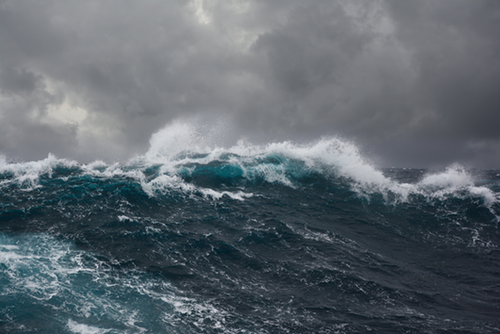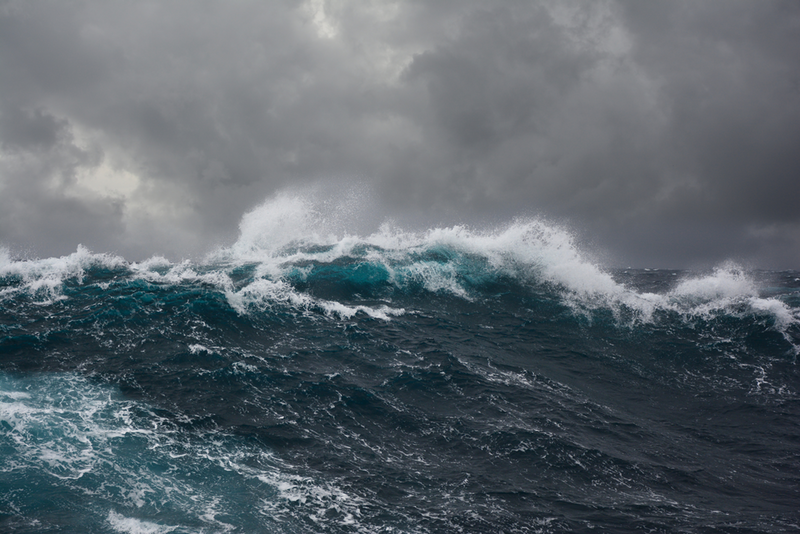Making Rogue Waves with Wind and Water
A rogue wave is a tower of water that appears out of nowhere in a sea of smaller waves, and researchers are still uncertain about how they form. Experiments have produced them in water tanks with mechanical systems such as paddles, but now a team has generated rogue waves more realistically, using wind. The observations support the commonly held notion that a self-focusing effect can drive rogue wave formation. The new experimental technique could help researchers refine predictions of rogue waves, which threaten ships and drilling platforms.
Rogue waves were long considered to be a sailors' myth, but in 1995, a 25-meter-high wave was recorded by instruments on an oil platform in the North Sea [1]. That freak occurrence inspired researchers to recreate rogue waves in the lab. Typically, those experiments involved long, straight wave tanks with mechanical wave generators, such as paddles, that created wave trains with a specific wavelength.
When rogues were seen in these controlled settings, the analysis showed that they were generally not the result of some chance combination of multiple waves adding up to a large one. Instead, the majority of lab rogues grew out of a self-focusing of waves called modulation instability [2]. The waves start out with a single dominant wavelength, but a perturbation makes one wave a little taller than the others. The waves behind this perturbation speed up, while the waves ahead slow down, causing energy to pile up (or focus) on the perturbed wave until it grows into a rogue. The effect is nonlinear in that one wave can affect the speed of another.
When physicists propose this explanation to marine scientists, the reaction is often, “But what about the wind?” says Alessandro Toffoli from the University of Melbourne in Australia. Ocean waves are not created by paddles but by wind interactions with the water surface. The problem with past wind-based experiments has been that the tanks are not long enough for rogues to develop. So Toffoli and his colleagues designed a ring-shaped tank—housed at the University of Turin in Italy—where water and air can move around endlessly.
The team filled the 5-meter-diameter tank with water to a depth of half a meter and set two fans to blow air over the water surface in a counterclockwise direction. They turned on the fans and quickly achieved a steady wind speed of 4 meters per second (10 miles per hour). The waves grew in height relatively slowly, taking about half an hour to reach a stable “sea state,” for which the average height of the most visible waves was about 5 cm. In the data, the team was able to spot a number of rogue waves, defined as single waves that are 2.2 times taller than the average.
The rogue waves occurred predominantly in the period right before the stable state was reached. Statistical analysis of the intensity (which is related to wave height) also showed that during this same time period the population of waves changed. The number of waves with a certain intensity usually drops sharply towards higher intensity, but during this time, this drop-off was less steep, replaced by a "heavy tail"—meaning that more intense waves became more numerous. This heavy tail is a signature that nonlinear effects are acting strongly, thus affirming previous work that found a connection between nonlinearity and rogues. The team acknowledges, however, that the waves in their tank are not fully representative of the ocean.
Oceanographer Alvise Benetazzo from the Marine Science Institute (ISMAR) in Venice, Italy, thinks the authors have found an original approach with their ring-shaped wave tank, and he is intrigued by the timing of the high incidence of rogues, right before the onset of the stationary sea state. Physical oceanographer Johannes Gemmrich from the University of Victoria in Canada is also surprised by this timing, and he wonders if it might be an artifact of the way the average wave height is measured. Toffoli admits uncertainties over averaging techniques, but this does not affect their measure of a heavy tail distribution. He and his colleagues are therefore certain that nonlinear dynamics ramp up, but as of now they are not sure why this occurs just before the wave heights level off.
This research is published in Physical Review Letters.
–Michael Schirber
Michael Schirber is a Corresponding Editor for Physics Magazine based in Lyon, France.
References
- E. M. Bitner-Gregersen, L. Fernandez, J. M. Lefèvre, J. Monbaliu, and A. Toffoli, “The North Sea Andrea Storm and Numerical Simulations,” Nat. Hazards Earth Syst. Sci. 14, 1407 (2014).
- V.E. Zakharov and L.A. Ostrovsky, “Modulation instability: The beginning,” Physica D: Nonlinear Phenomena 238, 540 (2009).





